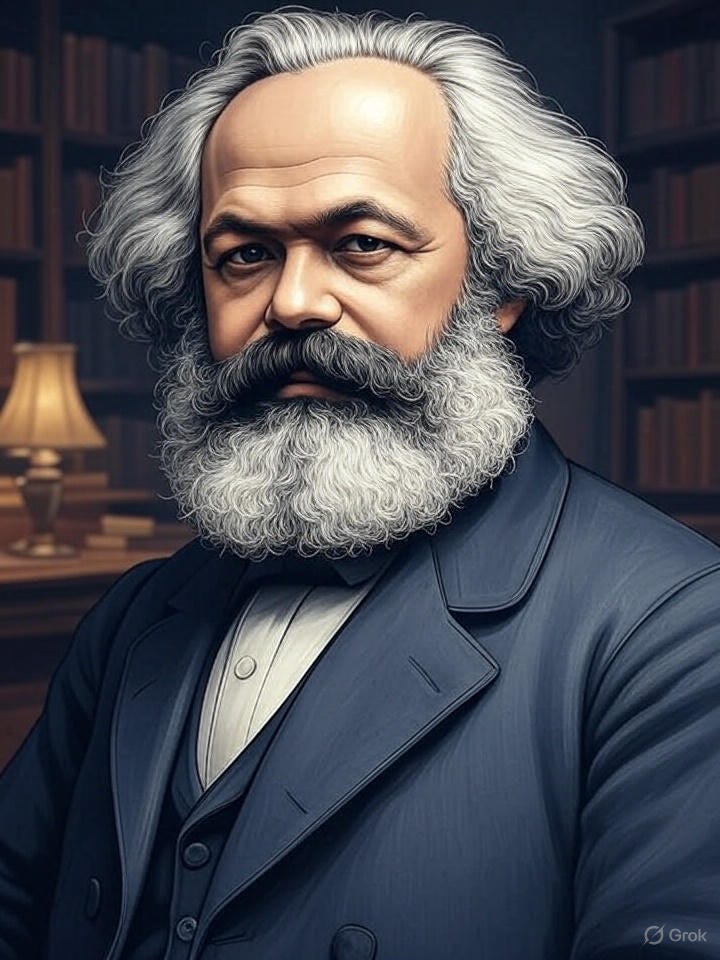The Communist Manifesto And Today
While voters are considering candidates like Mamdani
[Note: Today’s post veers away from our usual blend of concise news snippets or thought-provoking essays. This is a continuation of the Mamdani piece I penned a few days ago. For those who missed it, the entire essay was intended as tongue-in-cheek satire—hopefully, that was clear! We know some readers struggle to shift from serious to humorous tones, and humor doesn’t always leap off the page. It was satire, pure and simple.
That said, it got me thinking about Karl Marx and The Communist Manifesto, and whether its ideas could take root in America. Mamdani seems to think so.
This piece delves into the origins of communism, its various implementations, and how they’ve fared in the modern world.
On a side note, conversations with people from China suggest many view their government positively. To hold this view, you’d need to prioritize the state over personal desires. Individualism isn’t encouraged, and freedoms like a free press or speech are absent. The government holds all the power, and those who resist are sidelined—willingly or otherwise. If you’re ready to trade individuality for the collective, communism might appeal. Plus, as Mamdani notes, it promises plenty of free benefits.]
The Communist Manifesto, Its Implementations, and Effect on the Proletariat
Below is a concise summary of The Communist Manifesto by Karl Marx and Friedrich Engels, originally published in 1848. The summary captures the core arguments, historical context, and key ideas while condensing the text into a clear and accessible format.
Introduction & Context
The Communist Manifesto (1848), by Karl Marx and Friedrich Engels, is a revolutionary pamphlet critiquing capitalism and advocating communism. Commissioned by the Communist League amid Europe’s Industrial Revolution upheavals, it highlights class struggle—between the bourgeoisie (capitalist elite) and proletariat (working class)—as history’s driver. Opening with “A spectre is haunting Europe—the spectre of communism,” it aims to clarify communist goals, dispel myths, and offer a materialist analysis of societal change. Structured in four sections, it focuses on class conflict and communist strategy, rooted in the 1840s’ revolutionary ferment.
Bourgeois & Proletarians
The first section traces class struggle from feudal lords vs. serfs to bourgeoisie vs. proletariat. The bourgeoisie, born from industrial capitalism, amassed wealth via technology and trade but deepened inequality. The proletariat, lacking production means, endures exploitation, selling labor for survival. Marx calls their underpaid work “surplus value,” fueling alienation. Capitalism’s overproduction and crises will, the Manifesto predicts, empower the proletariat to overthrow the bourgeoisie and build a classless society.
Proletarians & Communists
The second section defines communists as the proletariat’s vanguard, aiming to abolish exploitative private property (e.g., factories, not homes). Goals include uniting the working class, seizing power, and establishing collective ownership. Proposed measures—abolishing land ownership, inheritance, and centralizing credit—aim to redistribute wealth by need, freeing individuals from oppression.
Critique of Other Socialisms
The third section critiques rival socialist movements: reactionary (restoring feudalism), bourgeois (reforming capitalism), and utopian (idealistic but impractical). Marx and Engels champion communism as a scientific, revolutionary alternative, rejecting half-measures that ignore class struggle’s root causes.
Strategy & Vision
The final section outlines a global strategy, supporting any pro-proletariat movement while pushing for capitalist property’s end. With “Working Men of All Countries, Unite!” it calls for international worker solidarity. Predicting capitalism’s collapse, it ends defiantly, asserting history favors communism. Though influential, its vision of a happy, classless society remains unproven.
Did Communism Work for a Happy Proletariat?
No communist regime fully delivered Marx’s vision of a liberated, happy proletariat. Key examples:
Soviet Union (1917–1991): Industrialized, offered free healthcare/education, but Stalin’s purges and famines (e.g., Holodomor) crushed freedoms and happiness, leading to its 1991 collapse.
China (1949–present): Lifted 800 million from poverty post-1980s, yet famines, repression, and inequality mar its record.
Cuba (1959–present): Excels in healthcare/education but suffers shortages and restricts freedoms, driving emigration.
Others (Vietnam, Laos, North Korea): Vietnam and Laos saw economic gains with reforms, but repression lingers. North Korea’s poverty and tyranny ensure misery.
Centralized control often bred inefficiency and coercion, deviating from Marx’s ideals. Capitalist systems, despite flaws, often outperformed in living standards and freedom.
Ranking Proletariat Happiness
1. United States: High GDP ($85,373), freedoms, and opportunities, though inequality (Gini 0.41) and no universal healthcare persist.
2. China: Economic growth ($13,200 GDP) offset by repression and disparities.
3. Vietnam: Modest gains ($4,500 GDP) hampered by political limits.
4. Cuba: Strong social services but economic woes and freedom curbs.
5. Soviet Union: Early benefits eroded by repression.
6. Laos: Limited progress due to poverty.
7. North Korea: Extreme suffering from isolation and tyranny.
The US leads due to autonomy and prosperity, though inequality echoes Marx’s critiques. Communist systems gained ground with reforms but failed to sustain happiness under strict ideology. X posts show mixed views, with some lauding resistance to the West, others decrying repression. Data gaps and external pressures (e.g., sanctions) complicate comparisons.



